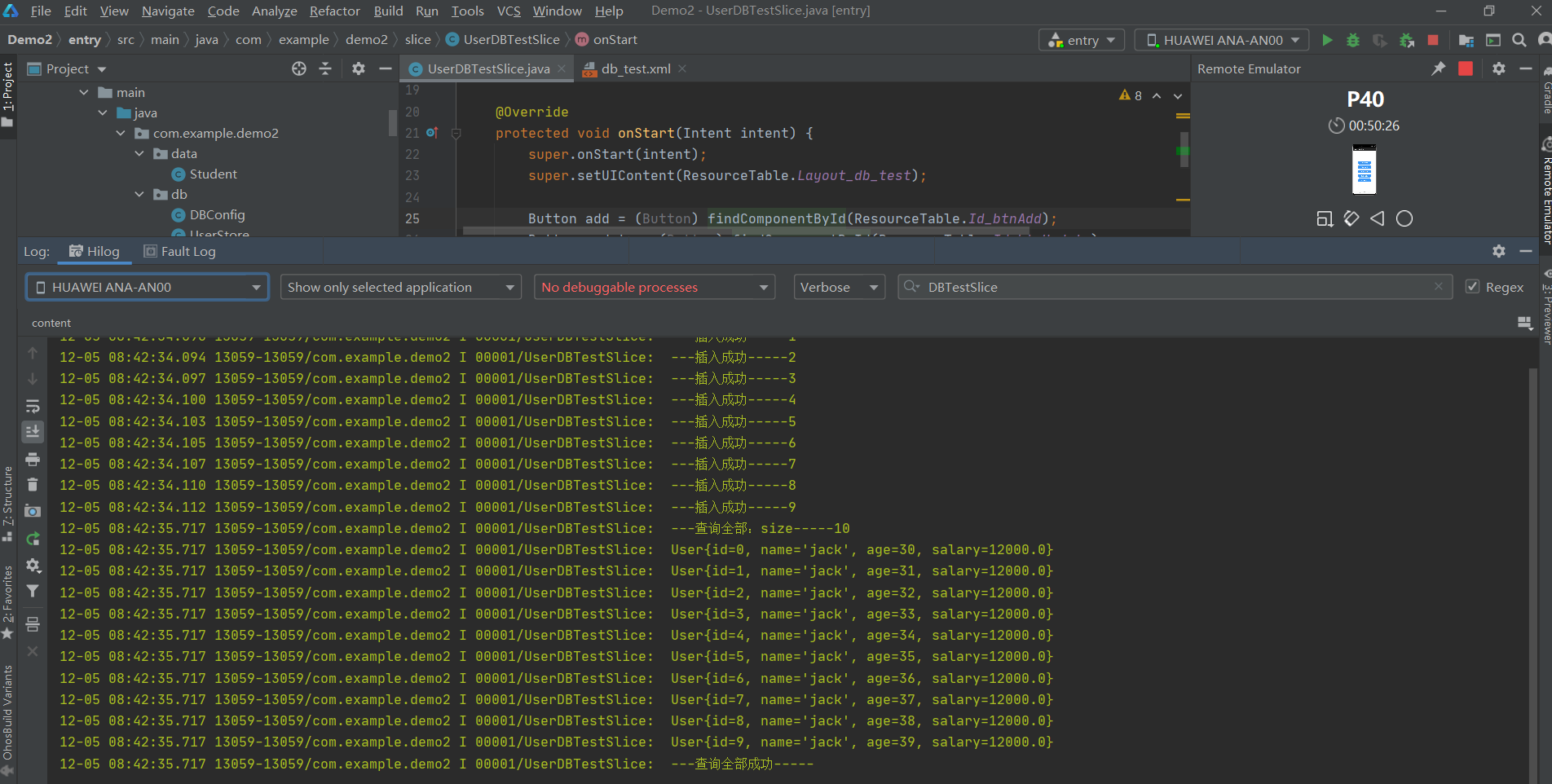1.配置
2.使用
一 配置
HarmonyOS 基础数据库 - biind - 博客园 (cnblogs.com)
跟基础数据库配置一样
二 使用
1.新建entiry类,继承OrmObject
2.新建store类,继承OrmDatabase
3.新增、更新、删除、查询单条,查询集合
package com.example.demo2.db; import com.example.demo2.entity.User; import ohos.data.orm.OrmDatabase; import ohos.data.orm.annotation.Database; import ohos.data.rdb.RdbOpenCallback; @Database(entities = {User.class}, version = 1) public class UserStore extends OrmDatabase { @Override public int getVersion() { return 0; } @Override public RdbOpenCallback getHelper() { return null; } }
package com.example.demo2.entity; import ohos.data.orm.OrmObject; import ohos.data.orm.annotation.Entity; import ohos.data.orm.annotation.PrimaryKey; @Entity(tableName = "user") public class User extends OrmObject { @PrimaryKey(autoGenerate = true) private int id; private String name; private int age; private double salary; public User() { } public User(int id, String name, int age, double salary) { this.id = id; this.name = name; this.age = age; this.salary = salary; } public int getId() { return id; } public void setId(int id) { this.id = id; } public String getName() { return name; } public void setName(String name) { this.name = name; } public int getAge() { return age; } public void setAge(int age) { this.age = age; } public double getSalary() { return salary; } public void setSalary(double salary) { this.salary = salary; } @Override public String toString() { return "User{" + "id=" + id + ", name='" + name + '\'' + ", age=" + age + ", salary=" + salary + '}'; } }
package com.example.demo2.db; import ohos.app.Context; import ohos.data.DatabaseHelper; import ohos.data.orm.OrmContext; import ohos.data.orm.OrmMigration; import ohos.data.rdb.RdbOpenCallback; import ohos.data.rdb.RdbStore; import ohos.data.rdb.StoreConfig; import ohos.hiviewdfx.HiLog; import ohos.hiviewdfx.HiLogLabel; public class DBConfig { private final HiLogLabel HI_LOG_LABEL = new HiLogLabel(HiLog.LOG_APP, 1, "DBConfig"); private String data_base_name = "mydb.db"; private String data_base_name_alias = "mydb"; private DatabaseHelper databaseHelper; private OrmContext ormContext; private StoreConfig config; private RdbStore rdbStore; public DBConfig(Context context) { databaseHelper = new DatabaseHelper(context); } public OrmContext getConnectionContext(Class store) { this.ormContext = databaseHelper.getOrmContext(data_base_name_alias, data_base_name, store, new OrmMigration[0]); return this.ormContext; } public RdbStore getConnectionWithSql(String sql) { config = StoreConfig.newDefaultConfig(data_base_name); rdbStore = databaseHelper.getRdbStore(config, 1, new RdbOpenCallback() { @Override public void onCreate(RdbStore rdbStore) { rdbStore.executeSql(sql); } @Override public void onUpgrade(RdbStore rdbStore, int i, int i1) { }
package com.example.demo2.utils; import com.example.demo2.data.Student; import com.example.demo2.db.DBConfig; import com.example.demo2.db.UserStore; import com.example.demo2.entity.User; import ohos.app.Context; import ohos.data.orm.OrmContext; import ohos.data.orm.OrmPredicates; import ohos.data.rdb.ValuesBucket; import ohos.data.resultset.ResultSet; import java.util.ArrayList; import java.util.List; public class UserUtils { private OrmContext orm; private DBConfig config; public UserUtils(Context context) { config = new DBConfig(context); orm = config.getConnectionContext(UserStore.class); } public boolean insert(User user) { boolean insert = orm.insert(user); return orm.flush(); } public boolean delete(int id) { OrmPredicates predicates = orm.where(User.class).equalTo("id", id); int i = orm.delete(predicates); return i > 0 ? true : false; } public boolean update(int id, User user) { OrmPredicates predicates = orm.where(User.class).equalTo("id", id); ValuesBucket bucket = new ValuesBucket(); bucket.putInteger("id", user.getId()); bucket.putString("name", user.getName()); bucket.putInteger("age", user.getAge()); bucket.putDouble("salary", user.getSalary()); int i = orm.update(predicates, bucket); return i > 0 ? true : false; } public List<User> queryList(String name) { List<User> list = new ArrayList<User>(); OrmPredicates predicates = orm.where(User.class).like("name", name); ResultSet query = orm.query(predicates, new String[]{"id", "name", "age", "salary"}); while (query.goToNextRow()) { User user = new User(); user.setId(query.getInt(query.getColumnIndexForName("id"))); user.setName(query.getString(query.getColumnIndexForName("name"))); user.setAge(query.getInt(query.getColumnIndexForName("age"))); user.setSalary(query.getDouble(query.getColumnIndexForName("salary"))); list.add(user); } return list; } }
}); return rdbStore; } }
package com.example.demo2.slice; import com.example.demo2.ResourceTable; import com.example.demo2.data.Student; import com.example.demo2.entity.User; import com.example.demo2.utils.StudentUtils; import com.example.demo2.utils.UserUtils; import ohos.aafwk.ability.AbilitySlice; import ohos.aafwk.content.Intent; import ohos.agp.components.Button; import ohos.agp.components.Component; import ohos.hiviewdfx.HiLog; import ohos.hiviewdfx.HiLogLabel; import java.util.List; public class UserDBTestSlice extends AbilitySlice { private final HiLogLabel hiLogLabel = new HiLogLabel(HiLog.LOG_APP, 1, "UserDBTestSlice"); @Override protected void onStart(Intent intent) { super.onStart(intent); super.setUIContent(ResourceTable.Layout_db_test); Button add = (Button) findComponentById(ResourceTable.Id_btnAdd); Button update = (Button) findComponentById(ResourceTable.Id_btnUpdate); Button delete = (Button) findComponentById(ResourceTable.Id_btnDelete); Button one = (Button) findComponentById(ResourceTable.Id_btnQueryById); Button list = (Button) findComponentById(ResourceTable.Id_btnQueryAll); add.setClickedListener(this::onClick); update.setClickedListener(this::onClick); delete.setClickedListener(this::onClick); one.setClickedListener(this::onClick); list.setClickedListener(this::onClick); } private void onClick(Component component) { if (component.getId() == ResourceTable.Id_btnAdd) { try { for (int i = 0; i < 10; i++) { User user = new User(i, "jack", 30 + i, 12000); boolean b = new UserUtils(UserDBTestSlice.this).insert(user); if (b) { HiLog.info(hiLogLabel, "---插入成功-----" + i); } } } catch (Exception e) { HiLog.info(hiLogLabel, "---插入失败-----" + e.getMessage()); } } if (component.getId() == ResourceTable.Id_btnQueryAll) { try { List<User> list = new UserUtils(UserDBTestSlice.this).queryList("jack"); HiLog.info(hiLogLabel, "---查询全部:size-----" + list.size()); for (int i = 0; i < list.size(); i++) { HiLog.info(hiLogLabel, list.get(i).toString()); } HiLog.info(hiLogLabel, "---查询全部成功-----"); } catch (Exception e) { HiLog.info(hiLogLabel, "---查询全部失败-----" + e.getMessage()); } } } @Override protected void onActive() { super.onActive(); } @Override protected void onForeground(Intent intent) { super.onForeground(intent); } }
<?xml version="1.0" encoding="utf-8"?> <DirectionalLayout xmlns:ohos="http://schemas.huawei.com/res/ohos" ohos:height="match_parent" ohos:width="match_parent" ohos:alignment="center" ohos:orientation="vertical"> <Button ohos:id="$+id:btnAdd" ohos:height="50vp" ohos:width="200vp" ohos:background_element="$graphic:background_button" ohos:text="新增1条数据" ohos:text_color="#FFFFFF" ohos:text_size="20fp" ohos:top_margin="20vp"> </Button> <Button ohos:id="$+id:btnDelete" ohos:height="50vp" ohos:width="200vp" ohos:background_element="$graphic:background_button" ohos:text="删除1条数据" ohos:text_color="#FFFFFF" ohos:text_size="20fp" ohos:top_margin="20vp"> </Button> <Button ohos:id="$+id:btnUpdate" ohos:height="50vp" ohos:width="200vp" ohos:background_element="$graphic:background_button" ohos:text="更新1条数据" ohos:text_color="#FFFFFF" ohos:text_size="20fp" ohos:top_margin="20vp"> </Button> <Button ohos:id="$+id:btnQueryById" ohos:height="50vp" ohos:width="200vp" ohos:background_element="$graphic:background_button" ohos:text="查询1条数据" ohos:text_color="#FFFFFF" ohos:text_size="20fp" ohos:top_margin="20vp"> </Button> <Button ohos:id="$+id:btnQueryAll" ohos:height="50vp" ohos:width="200vp" ohos:background_element="$graphic:background_button" ohos:text="查询全部数据" ohos:text_color="#FFFFFF" ohos:text_size="20fp" ohos:top_margin="20vp"> </Button> </DirectionalLayout>

